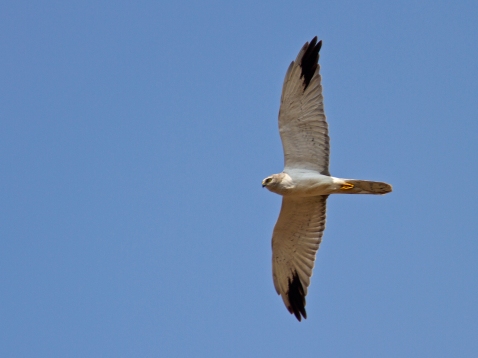This morning felt like autumn. Cold on the hands, and mist hanging in the road’s low-lying hollows. Scudding dense clouds doubled the dark in the early hours. On the edge of Sheppey’s marshes, where the Harty church hunkers squat, I waited, alone and silent.
It broke suddenly at first light, as though conjured with light from dark hedge and thorn. Last week I’d happened upon this very bird at Elmley reserve, further west along the estuary – a young pallid harrier; slender-winged, ring-tailed, collared, rich chocolate-brown, with underparts the colour of October stubble fields, fermenting windfall. It quartered between sheep, rested in the sallow grass, then lifted out of sight over the sea wall. In the following week it was sighted briefly elsewhere, before it settled for happy hunting along these fields that slope to the Swale mud. Today I was back for a second glance. The bird burst into the still, flushed a partridge, and sat mid-field to pluck and tear.

The Isle of Sheppey pallid harrier (Image: Malcolm Freeman, from Bird Guides)
Once, aged ten, I found a red-backed shrike on the cliff top at Walton-on-the-Naze. I ran all the way back to the beach to fetch my father, desperate to show him the bird, impatient at his slowness the whole way back. But this pallid harrier is my first self-discovered big rarity. It’s a bird at home far, far east of here – Ukraine, Kazakhstan, on the Russian Steppes – and should be wintering in Africa or India. It’s what’s known in birding terms as a ‘vagrant’ – an avian wanderer off course, far outside its normal range. All birds are vagrants in a sense, of course. That’s what makes them so compelling – airborne, liberated from our earthbound mammalian living, they are masters of travel, the embodiment of mystery because they take off as they please, pursuing directions that seem to us entirely directionless and unpredictable. Some birds make seasonal journeys across the globe, flying great distances north to breed, and south again to winter in warmer climes where food is more abundant. Many of our much-loved, most familiar, British birds are ‘migrants’ (the ornithological term for these birds that have specific, come-and-go seasonal flight routes): swallows, nightingales, cuckoos, turtle doves. They all winter in Africa and breed in Northern Europe. Other birds – curlew sandpiper, arctic tern, corncrake – stop briefly to feed on their return from breeding grounds in the Arctic or far north of Britain. It works the other way around too – some birds such as the barnacle goose, fieldfare, whooper swan come to our comparatively temperate shores from the high Arctic to see out the winter.

A male pallid harrier, at home in steppe country.

Juvenile pallid at Falsterbo, Sweden. (Image: Sean Nixon)
Migrants can usually be expected, if you’re in the right time and the right place. Vagrants, however, offer no such assurances, which is, of course, what makes them so exciting to birdwatchers. These are the wayward wanderers, the migrants who got it wrong, who end up the other side of the world, sometimes as far from ‘home’ as it’s possible to get. In May and October (traditionally the most active migration months), the frisson of finding and watching is intensified, because these are the times when great rarities occur: Yanks blown across the Atlantic by tremendous weather fronts to land on west-facing isles or fall exhausted onto ships; tiny warblers bound from Siberia to southeast Asia whose fuddled magnetic sensibilities send them off in entirely the wrong direction; birds that overshoot their destinations by hundreds of miles. Some birders will go to great extremes to add these birds to their lists – ‘twitchers‘ who travel the length and breadth of the UK for each species as soon as it’s reported. (One chap who joined me watching the harrier a little later this morning had just returned from twitching an eastern kingbird (from North America) on the Isle of Barra; a fourteen hour trip from the outer Hebrides, two hours in between to grab a coffee back home in Slough, and he was on the road again to see the Sheppey harrier.)

Pallas’s warbler – a birder’s favourite October/November vagrant from far east Siberia.
It’s not clear precisely why pallid harriers turn up on British shores – as with other raptors, these individuals may be wandering, inexperienced juveniles straying beyond their range, or even seeking and expanding territories (the species’ range has begun to stretch westwards). It’s still a very rare species, but more and more seem to be turning up here during autumn months.
Taking pleasure in these lost or outlying birds seems perverse in one sense; they are, after all, moribund creatures – their mistakes or bad fortune may well be their end. Larger birds, like the harrier, are likely to fare better, correcting themselves or surviving well in their accidental wintering grounds. But the privilege of moments like these can and should inspire further wonder at the natural world, re-engage our sense of the everyday, which is suddenly and marvellously ignited when the new and mysterious come upon what we take to be old and known. Degrees of familiar and unfamiliar shift, for a time, though novelties – however strange or fine – so easily become ignored ordinaries. The pallid harrier brings to me an elsewhere, carries a yonder and farness to this here, now and near. It speaks of the world’s vastness, but collapses it, too, by connecting me briefly to long-travelled distances and encounters, shared lines of occurrence and being.
